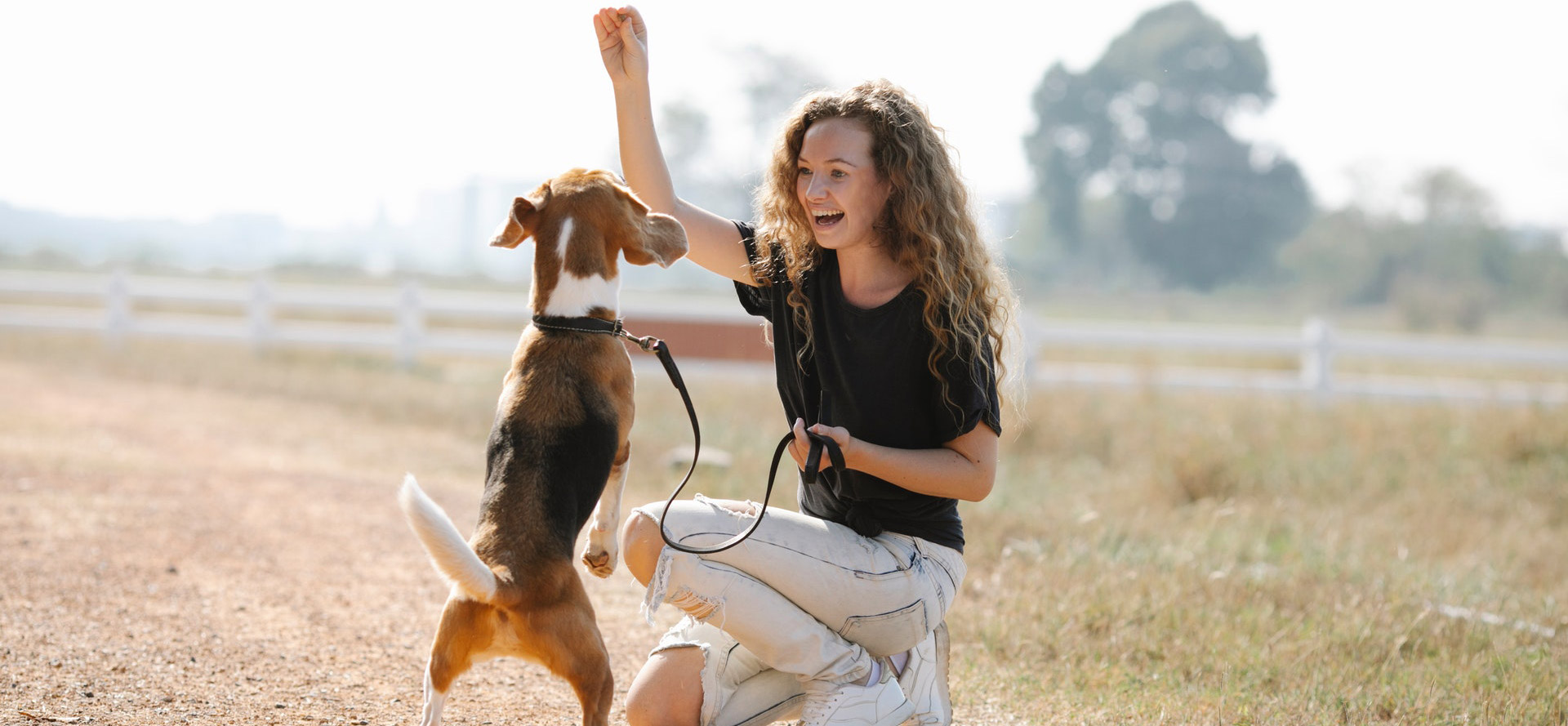Dog Behavior Training

It can be difficult, and sometimes even frustrating, to communicate with our pets. Unlike our human friends and family members, our pets don’t speak the same verbal language as us. This makes explaining what we want from them or, even more complicated, why they should listen to us a near-impossible task. Instead of communicating in this direct way, we can communicate necessary behavior changes to our dogs by training them. Dog training seems like an intimidating topic at first, but once you understand what kinds of training exist and how they are done, it will be a much easier thing to approach.
Training Types
Not all behavior training is the same, and when you are working one-on-one with a trainer, the training is typically tailored to the kind of behavioral problem your dog is having. Even in a training class, the lesson plans will be different depending on the general type of behavioral problems that are being addressed. There are many different types of training to suit the virtually infinite types of behavior issues that can exist, but for today, we will just talk about a few of the most significant ones which you are most likely to need.
Training for Aggressive Dogs
Training for aggressive dogs, which is intended to reduce the dog’s aggressive behavior, can be tricky and time-consuming. Unlike in other types of dog training, the dog is likely to resist listening to you in aggressive dog training. Because of this, training for aggressive dogs is often centered around establishing your role as the leader and setting strict rules that your dog must be required to follow, in order to mitigate any dominant behavior towards you and make it easier for you to control their aggression towards other people or other animals. In some cases, training for aggressive dogs can be a relatively simple matter of convincing the dog that they will not get what they want by being aggressive.
Training for Mistreated Dogs
When you adopt a rescue dog, it’s quite possible that you will encounter strange behavioral issues that are the result of abuse from a previous owner. In order to train these dogs out of their conditioned habits, you must establish trust with them and show them that situations that were previously frightening or painful for them need not be so anymore. Mistreated rescue dogs can be trained out of their separation anxiety, their fear of strangers, and other habits with dedication.
Training for Puppies
Many dogs need training not because they have any specific personality issues, but because they don’t understand how to behave appropriately with people. Generally speaking, basic obedience training is sufficient to teach puppies, and even adult dogs that have never been properly trained, how to listen to their owner and behave in an appropriate, non-destructive way in your home and in the world. The commands taught in basic obedience training may include:
- Name recognition
- “Come”
- “Sit”
- “Stay”
- “Down”
- “Leave it”
and other commands that will help teach your dog to pay attention to you and understand what you need them to do.
Training Tools
Of course, the most important thing about training is the method and, unless you’re doing all of the training yourself, the trainer you choose. However, there are a number of dog training tools available, and there is no reason not to take advantage of them if you feel that they would make your journey with your dog easier. Dog training tools may aid training directly, by encouraging your dog to complete commands as instructed, or indirectly, by making the process easier for you, the trainer, or by giving you additional knowledge about the training.
Dog Training Treats
Treats are commonly used in all types of dog behavior training, and although it is possible to train your dog without treats, they are used with good reason. In general, you need some reward to give your dog when they perform a command correctly or choose the appropriate action. Rewards like toys and praise can also work, but these are lower-value rewards than food for most dogs. Training treats are small and low-calorie so that you can give many rewards over a training session without significantly overfeeding your dog. If you choose to use normal treats, breaking them up into smaller pieces can also achieve this effect.
Dog Behavior Collars
Training collars work on the opposite principle from the one treat training is based on; they introduce a negative stimulus when a command is ignored or an incorrect behavior is chosen, to discourage the dog from repeating the mistake. The best collars for training are electronic, with different settings and a remote that allows you to control the stimulus your dog receives from a distance during the session. Many people think of electronic collars as delivering a painful shock, but gentler options like vibration and sound are also available. These options, while seemingly less negative or less severe, still achieve the same effect of discouraging the dog from performing a certain action.
Clickers
Clickers are used to indicate the moment in which your dog does something correctly. When you give your dog a verbal cue to indicate that they have done well, it often is longer than a single sound or syllable, so that your dog knows that they have done something right, but they may not know exactly what part was most important. When you train your dog with a clicker, they have a clear indication of the exact moment when they performed the command correctly or made the correct decision.
Dog Behavior Books
Dog experts and dog trainers are very familiar with the fact that most people are not sure of how to train a dog properly, and that not everyone has the budget for training classes or private training sessions for their dog. That’s why so many people have written books to guide the training process. You can purchase dog training books to help you with:
- Training puppies and general obedience
- Understanding dog body language and cues
- Training aggressive dogs
- Training service dogs
- Teaching specialized tricks, such as agility course skills and more.
Conclusion
Dog behavior training can seem daunting at first because it requires understanding behaviors and body language cues that you might not be familiar with in order to successfully modify them. It’s good to take behavior training seriously, but there’s no reason to view it as an impossible or unpleasant task. Training your dog is likely to strengthen the bond between the two of you, and it is certain to improve your dog’s behavior and make both of your lives better and easier. Now that you know more about dog behavior training, we hope you feel more comfortable with the idea. You can always take a look at our product reviews to find the best options for different training tools that will make the process easier.
FAQs
How do I train my dog to walk on a leash?
The best way to train a dog to walk easily on a leash is to teach them the command “heel”. This command brings the dog close to your side, so that they are never pulling on the leash or running so far from you that they fail to follow your commands. Treats are ideal for training “heel”, and you may also use tools like front-lead harnesses to make the acquisition of this skill faster for your dog.
How should I train my dog?
How you train your dog is up to you, and as long as the correct amount of effort is put into it, any training can bring about the results you want. You may decide to bring your dog to an obedience class, to book sessions with a professional dog trainer, or to train them yourself, based on your own independent research into dog training. In any of these cases, the type of training that should be focused on depends on the behavioral issues of your dog. Aggressive dogs and submissive dogs, puppies and older dogs, and breeder and rescue dogs will all need to be trained differently, according to their different personalities.
How do you stop aggressive behavior in dogs?
Aggressive behavior in dogs can be a complicated thing to fix, especially if the dog is an adult by the time, you adopt them and observe these issues. That said, it is never impossible to train a dog to correct their behavior, and even the most aggressive dogs can be corrected with time. One of the most important steps in aggressive dog training is to establish that you are in charge and must be listened to by the dog, and that the rules you set cannot be broken.
How do you correct a dog’s behavior?
The specific type of training that will correct a dog’s behavior will depend, of course, on what problems they are having and what needs to be corrected. That said, any behavior is corrected either by rewarding correct behavior or by punishing incorrect behavior. Either or both of these methods will help your dog to learn what is appropriate and what is not.
Tags: pet foods supplies, dog stairs, extra large outdoor dog kennel, biggest and scariest dog breeds, electric dog nail clippers, why does my cat lay on my chest, can dogs have raw chicken, is pepperoni safe for cats, high pitch dog whistle, retractable dog leash with light




